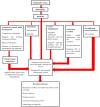Proposed framework for the integration of refractive error services into the eye health ecosystem in Kenya via social enterprise
- PMID: 39789095
- PMCID: PMC11718059
- DOI: 10.1038/s41598-024-85006-7
Proposed framework for the integration of refractive error services into the eye health ecosystem in Kenya via social enterprise
Abstract
The global burden of uncorrected refractive error demands for adoption of different approaches inclined towards scaling effective refractive error coverage. While innovative approaches such as utilization of telemedicine is being adopted by social enterprises in different parts of the world to scale refractive error service delivery, commercial entrepreneurship still dominates the optical industry in Kenya with minimal focus on accessibility and affordability. However, to achieve effective refractive error coverage across the economic pyramid, integration of enterprises inclined towards fulfilling a social mission through innovative approaches such as telemedicine is desirable. This study thus developed a framework for the integration of refractive error services into the eye health ecosystem in Kenya, via social enterprise. This was an exploratory study which entailed a scoping review of current models used by social enterprises and development of a framework for the integration of refractive error services into the eye health ecosystem via social enterprises, through expert opinion. The data was collected through telephonic and online interviews with key opinion leaders. The preliminary framework developed was presented to the key opinion leaders for comments and inputs through the Delphi technique. Thereafter, the final proposed framework for integration of refractive error services into the eye health ecosystem in Kenya via a social enterprise was developed. All of the key opinion leaders 10 (100%) agreed that social enterprises are worthy of attention when it comes to scaling cost effective refractive error service delivery in Kenya. A total of (n = 28; 80%) Key Opinion leaders identified vision centres, (n = 28; 80.0%) cross-subsidization, (n = 32; 91.4%) skills development, (n = 35; 100%) partnership and (n = 35; 100%) technology as critical components in scaling effective refractive error coverage in a resource constrained country such as Kenya. There was consensus among all the key opinion leaders (n = 35; 100%) that social enterprises are well placed to implement innovative approaches such as telemedicine to scale effective refractive error coverage in Kenya. The framework developed integrates aspects such as technology, partnership, referral, cross-subsidization, skills development and vision centres. It is anticipated that through engagement of social enterprises, integration of critical aspects such as human resources, awareness/education, cost efficiency, research and service delivery could potentially be enhanced.
Keywords: Framework; Integration; Refractive error; Social enterprise; Telemedicine.
© 2025. The Author(s).
Conflict of interest statement
Declarations. Competing interests: The authors declare no competing interests.
Figures





Similar articles
-
Proposed task shifting integrated with telemedicine to address uncorrected refractive error in Kenya: Delphi study.BMC Health Serv Res. 2024 Jan 22;24(1):115. doi: 10.1186/s12913-024-10618-8. BMC Health Serv Res. 2024. PMID: 38254104 Free PMC article. Review.
-
SWOT analysis of the models used by social enterprises in scaling effective refractive error coverage to achieve the 2030 in SIGHT in Kenya.Sci Rep. 2024 Feb 14;14(1):3750. doi: 10.1038/s41598-024-54493-z. Sci Rep. 2024. PMID: 38355981 Free PMC article. Review.
-
Telemedicine integration into the eye health ecosystem in scaling of effective refractive error coverage in Kenya.Sci Rep. 2024 Aug 6;14(1):18170. doi: 10.1038/s41598-024-68993-5. Sci Rep. 2024. PMID: 39107375 Free PMC article.
-
Situation analysis of the social enterprises engaged in refractive error services delivery in Kenya.BMC Health Serv Res. 2025 May 5;25(1):644. doi: 10.1186/s12913-025-12831-5. BMC Health Serv Res. 2025. PMID: 40325456 Free PMC article.
-
Situation analysis on the integration of refractive error services provided by optometrists into the national health services in Kenya.BMC Public Health. 2024 May 29;24(1):1442. doi: 10.1186/s12889-024-18960-6. BMC Public Health. 2024. PMID: 38811959 Free PMC article.
References
-
- Morjaria, P., Ramson, P. & Gichangi, M. Services for refractive error in Kenya. J. Ophthalmol. East. Cent. South. Afr.https://www.researchgate.net/publication/279926992 (2013).
MeSH terms
LinkOut - more resources
Full Text Sources
Medical

